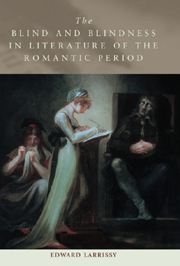Book contents
- Frontmatter
- Contents
- Preface
- Acknowledgements
- 1 The Enigma of the Blind
- 2 The Celtic Bard in Ireland and Britain: Blindness and Second Sight
- 3 Blake: Removing the Curse by Printing for the Blind
- 4 Edifying Tales
- 5 Wordsworth's Transitions
- 6 Coleridge, Keats and a Full Perception
- 7 Byron and Shelley: The Blindness of Reason
- 8 Mary Shelley: Blind Fathers and the Magnetic Globe: Frankenstein with Valperga and The Last Man
- 9 Conclusion
- Bibliography
- Index
8 - Mary Shelley: Blind Fathers and the Magnetic Globe: Frankenstein with Valperga and The Last Man
Published online by Cambridge University Press: 12 September 2012
- Frontmatter
- Contents
- Preface
- Acknowledgements
- 1 The Enigma of the Blind
- 2 The Celtic Bard in Ireland and Britain: Blindness and Second Sight
- 3 Blake: Removing the Curse by Printing for the Blind
- 4 Edifying Tales
- 5 Wordsworth's Transitions
- 6 Coleridge, Keats and a Full Perception
- 7 Byron and Shelley: The Blindness of Reason
- 8 Mary Shelley: Blind Fathers and the Magnetic Globe: Frankenstein with Valperga and The Last Man
- 9 Conclusion
- Bibliography
- Index
Summary
While the figure of the blind man may not be central to Mary Shelley's work, it is salient enough. The episode where Frankenstein's creature hides in the house of the blind De Lacey and his family is highly significant for the meaning of the book, as is the ensuing one in which he makes himself known to the old man, whose blindness means that he cannot react with prejudice to the creature's hideousness. In the second chapter of the first volume of Valperga (1823), we learn of the blindness of Euthanasia's father, Adimari, which prompts her to read to him and thus acquire learning. And not far from the end of The Last Man (1826), we encounter the blind old man, who remains ignorant of the fate of humanity, listening to his daughter playing Haydn's ‘New Created World’ (that is, music from his oratorio Creation): an event heavy with an irony which is central to Mary Shelley's intention. These episodes are intellectually and symbolically related. Both De Lacey and the blind father in The Last Man suffer from ignorance about a central element in the plot; and both love and enjoy a special sensitivity to music, in line with Enlightenment theories about the compensatory powers of blind people. De Lacey shares with Adimari the experience of listening to the reading aloud of educative literary and historical texts, even though, in the case of the former, it is the escaped Turkish girl Safie who is the intended auditor. Ignoring specificities, all could roughly be termed benevolent optimists. And all are fathers.
- Type
- Chapter
- Information
- The Blind and Blindness in Literature of the Romantic Period , pp. 188 - 203Publisher: Edinburgh University PressPrint publication year: 2007



